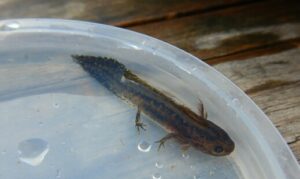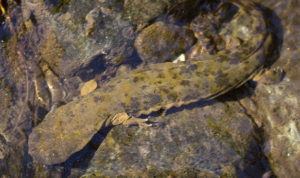We all know that salamanders love to spend a lot of their time in or around streams, ponds, or other water bodies. During the breeding season, it is common to see hundreds of salamanders migrating to ponds where they can swim freely and lay their eggs. But how long can salamanders stay underwater?
Salamander larvae have gills for breathing in the water and can stay underwater indefinitely. However, as adults, most salamanders lose their gills and can only stay underwater for a limited time. Depending on several factors, salamanders can stay underwater anywhere from a few seconds to as long as 6 hours.
Some salamander species such as the red-backed salamander have no aquatic larval stage. They hatch from eggs laid on land and live a fully terrestrial life from day one.
For this reason, these salamanders are not adapted for a life in water and have a very limited ability to breathe underwater. They can only be submerged for a very short period before they drown.
Salamander Larvae Can Stay Underwater Indefinitely
Most salamanders start their lives as tiny embryos inside an egg sack. These embryos will develop until they are ready to hatch into the water, typically in three to four weeks.
After hatching, the baby salamanders (larvae) will live a fully aquatic life and have external feathery gills attached to either side of their head, just where their necks should have been.
They use these gills to breathe underwater, just like fish.

Their gills have an extensive capillary network; Oxygen that is dissolved in the water that comes in contact with the gills is absorbed into their bloodstream via diffusion.
At the same time, carbon dioxide from the bloodstream passes through the gills and is diffused into the water.
This method of breathing gives salamander larvae all the oxygen they need so they can stay underwater for an unlimited amount of time.
Adult Salamanders Can Only Be Underwater for a Limited Time
After a few months, to as long as three years in some species, the larvae will go through a process known as metamorphosis and transform into adults.
During metamorphosis, they will lose their gills and develop limbs for walking on land.
Many (such as the tiger salamander) also develop lungs for breathing air. However, salamanders such as the red salamander do not develop any lungs, but instead, develop to breathe entirely through their skin and thin membranes in their mouths and throat (cutaneous respiration).
Since adult salamanders do not have gills, they breathe entirely through their skin when in the water. Dissolved oxygen in the water is absorbed through their skin, and into their bloodstream.
At the same time, carbon dioxide from the bloodstream passes through their skin and diffuses into the water.
This is very similar to the gaseous exchange that happens in the gills of the larvae. However, this method of breathing does not give adult salamanders all the oxygen they need, so they can only be underwater for a limited time before they have to resurface to get oxygen from the atmosphere.
How Long a Salamander Can Stay Underwater Is Mainly Dependent on 4 Factors
1. Water Oxygen Level
If the level of dissolved oxygen in the water is low, it will shorten the length of time a salamander can stay submerged. Many factors can affect the oxygen content of a water body.
For one, ‘stirred up’ water generally contains more oxygen than still water. This is because oxygen from the atmosphere mixes with the water easier.
If water is very still, oxygen only dissolves on the water’s surface, and anything below the upper layer of the water will have a low oxygen content.
2. Temperature
Salamanders are ectothermic (cold-blooded) animals, so the environmental temperatures will affect their rate of metabolism. At higher temperatures, they will have a higher metabolic rate, meaning they have a greater oxygen demand.
At lower temperatures, the opposite is true. Salamanders will have a lower metabolic rate meaning they have a lower oxygen demand.
Also, oxygen dissolves easier into colder water than into warmer water. This means the oxygen content of the water will be higher at colder temperatures, and lower at warmer temperatures.
All this combined means salamanders can stay underwater for much longer at colder temperatures than they can at warmer temperatures.
3. How Active the Salamander Is
Activity affects how much oxygen the body needs. Think about it, when we are running or jogging, we breathe heavier and in much quicker breaths than when we are at rest.
For salamanders, this is also true. They will have a higher oxygen demand when they are very active in the water (escaping a predator or chasing prey, for example), and a lower oxygen demand when they are inactive.
This means salamanders can stay underwater when at rest, for much longer than they can when they are very active.
4. Species
Some salamander species are better at absorbing oxygen from the water than others. For example, spotted salamanders can absorb oxygen from the water much more efficiently than arboreal or red-backed salamanders.
For this reason, they will be able to stay underwater for much longer than the latter.
Aquatic Salamanders Can Stay Underwater Indefinitely
Some salamanders live fully aquatic lives, even as adults. This means they have features that are adapted for life in the water, rather than on land.
Aquatic salamanders such as axolotls, sirens, and mudpuppies keep their gills as they develop into adults. They use these gills to breathe in the water, just like the larvae. This means they can stay underwater for an unlimited amount of time.
These salamanders are better suited for life in the water than on land, and can only be out of the water for a very short period before they have to return.
Some Aquatic Salamanders Breathe Entirely Through Their Skin
Aquatic salamanders such as the hellbender and Chinese/Japanese giant salamander lose their gills as they transform into adults and develop to breathe entirely through their skin.

These salamanders have skin that has lots of folds and wrinkles to increase the skin surface area, allowing it to absorb lots of oxygen from the water.
This way of breathing gives them all the oxygen they need so they can stay underwater for an unlimited amount of time.
Sometimes Adult “Terrestrial” Salamanders Have Gills
Some normally terrestrial salamanders never go through metamorphosis and develop to be fully aquatic, even as adults. They retain their gills, and other larval features, and continue to live in the water just like the larvae. This is known as neoteny.
It is essentially the larvae “refusing to grow up” and is most common in tiger salamanders and other mole salamanders.

Neoteny usually happens when the salamander larvae are in a pond with lots of food, making it unnecessary for them to metamorphose and leave the water.
It can also happen when the conditions on land are overly harsh (such as lack of food or overly dry conditions), making it necessary for the larvae to remain in the water.
Neotenic “terrestrial” salamanders continue breathing through their gills, just like the larvae, and can stay underwater for an unlimited amount of time.
Frequently Asked Questions
Question: Do Salamanders Have Lungs?
Answer: There are hundreds of salamander species that are all somewhat different from each other. Some salamander species such as the tiger salamander develop lungs as they transform into adults.
However, others such as the red salamander do not develop lungs and instead develop to breathe entirely through their skin.
Check out this post for more detailed information on this topic.
Question: Can a Salamander Drown?
Answer: Aquatic salamanders are adapted for life in the water, so they can stay underwater indefinitely without drowning. However, since terrestrial salamanders can only stay underwater for a limited time, they can drown if they stay underwater for too long.
Final Thoughts
Most salamanders start their lives in the water and will return to the water as adults during the breeding season. Since different salamander species have different ways of breathing, how long a salamander can stay underwater will depend on the species.
It will also be affected by external factors such as the temperature, and the oxygen content of the water. If the water conditions are ideal, some salamander species can stay underwater for a significant amount of time.

